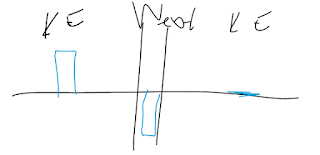The question asked of me, paraphrasing:
I gave my class a question on a test: a 20 kg object moves 4.0 m/s on a frictionless surface. It hits a spring with k = 1280 N/m, which compresses 0.5 m. How much work was done by the spring on the box?
The answer in the key is 160 J using W = delta K
The students used Wspring = Fspringdcos180 using Fs as 640 N, d is 0.5 m and they get 320 J. Why are they not supposed to use this equation?
Or they use W = delta K + delta Us and get 320 J.
What is going on?
The equation that work equals force times distance is ONLY valid when the force is constant. In this case, the force of a spring is not constant - the force depends on the distance the spring is compressed. So the student who used force times distance used an invalid equation.
The default for all questions about work should be to an energy bar chart. Don't think about equations, think about an energy bar chart.
The “Wext” column represents work done by an external force. In this case, there’s no work done by a force external to the object-spring system! The force of the spring on the object is internal to the object-spring system. The normal force and the gravitational force act perpendicular to the motion so do no work. So, writing bars + bars = bars – that is, considering energy conservation, the total energy initially plus the external work done on the system is equal to the final total energy – you’ll see that the 160 J of kinetic energy at first become 160 J of spring potential energy later.
Okay, that doesn’t help – you’re supposed to find the work done by the spring. So do an energy bar chart for just the object by itself:
An object by itself cannot have potential energy. PE comes from an interaction… just as gravitational PE requires earth to be part of the system you’re considering, spring potential energy requires the spring to be part of the system. So here, kinetic energy is the only possible energy! KE at the beginning disappears because the object comes to rest. By bars + bars = bars, the amount of kinetic energy plus the work done by external forces must equal zero. Since the object had 160 J of kinetic energy, the spring must do -160 J of work on the object.
It is true that the amount of work done by the spring is 160 J, and that’s also the same amount of potential energy stored in the spring-object system by (1/2)kx^2. Yes! But, you can’t consider both of these 160 J values separately. EITHER you’re considering the object by itself, in which case potential energy doesn’t exist; OR you’re considering the object-spring together, in which case there’s no work done by an external force, only potential energy.
Each time you do an energy problem, define the system clearly. Then use an energy bar chart.
Hope this helps!





Isn't the original kinetic energy 160J?
ReplyDeleteIt is - post is updated to reflect. Thank you for noticing and letting me know!
ReplyDeleteHow would you approach a collision problem? Say we have two carts approach each other with equal momentums, collide and stick together, stopping dead. In the system consisting of the two carts, there is some initial KE before the crash, and there's clearly zero KE in the system after the crash. But the two carts hit each other, so there was no external work done ... so how would you handle this in your bar chart?
ReplyDeleteAh... everything you say is correct - no work done by external forces. No potential energy gained to compensate for kinetic energy lost.
ReplyDeleteThat's accounted for by a bar on the right-hand side for "internal energy", also known as "thermal energy". The temperature of the carts goes up in this case, because the macroscopic kinetic energy of the carts changes into sub-microscopic kinetic energies of the molecules in the carts.
This is easier to understand if you've played squash - an indoor cross between racquetball and tennis. The ball is squishy, such that it barely bounces off the ground. Before you play, you literally must "warm up" the ball - hit it hard against the wall numerous times, each time converting the ball's kinetic energy into thermal energy, so much so that you feel the temperature difference in the warm ball.